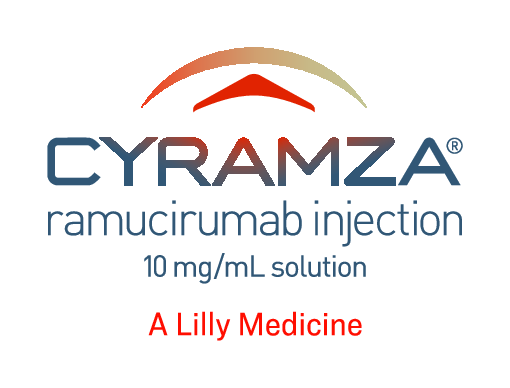
Meet CYRAMZA
How does CYRAMZA work? CYRAMZA is not a traditional chemotherapy. It is a type of treatment called an anti-angiogenic. This means CYRAMZA is thought to block the development of new blood vessels. (Tubular structures, such as veins, arteries, or capillaries, that carry blood through tissues and organs.) The development of new blood vessels is called angiogenesis.
Advanced or Metastatic Stomach or Gastroesophageal (GE) Junction Cancer
CYRAMZA is used by itself or with a chemotherapy medicine called paclitaxel to treat certain kinds of stomach cancer or cancer of the area where the stomach and esophagus (food pipe) meet that is advanced or has spread to other parts of the body. The area where the stomach and esophagus meet is often called the gastroesophageal (GE) junction. CYRAMZA is for adults whose stomach cancer got worse during or after certain other types of chemotherapy.
SELECT SAFETY INFORMATION
CYRAMZA may cause serious side effects, including:
Severe bleeding, including bleeding in the stomach or bowel, has happened with CYRAMZA. This can be life threatening. Tell your doctor right away if you have bleeding or symptoms of bleeding, including lightheadedness. If severe bleeding happens, you will have to stop receiving CYRAMZA.
You've decided to move forward and are ready to start treatment.
How is CYRAMZA given?
CYRAMZA is given alone or in combination with paclitaxel. Both CYRAMZA and paclitaxel are given by intravenous infusion, commonly referred to as an IV. The medicine will be delivered into your vein. A doctor or nurse will administer treatment at the doctor’s office, a hospital, or an infusion center.
Treatment with CYRAMZA alone
The time it will take to receive the first treatment infusion is about 60 minutes. CYRAMZA will be given to you once every 2 weeks, or as recommended by your doctor. If you handle the first infusion of CYRAMZA well, then your next infusions may take only 30 minutes. Your doctor will determine the number of treatments you receive.
Before you receive treatment with CYRAMZA, your doctor will administer different medicines to help prevent an allergic reaction that may occur during infusion.
Treatment with CYRAMZA in combination with paclitaxel
When you receive CYRAMZA in combination with paclitaxel, treatment will be given over a 28-day cycle. Your doctor will determine the number of treatments you receive. CYRAMZA will be given once every 2 weeks over the 28-day period. The first treatment infusion will take about 60 minutes. If you handle the first infusion of CYRAMZA well, then your next infusions may take only 30 minutes.
Paclitaxel will be given once a week for 3 weeks, and the infusion will take about 60 minutes. On the days you receive both medications, CYRAMZA will be given first, followed by paclitaxel.
No treatment will be given for the final week of the 28-day cycle.
SELECT SAFETY INFORMATION
CYRAMZA may cause serious side effects, including:
Reactions related to infusing CYRAMZA have happened. These can be severe and life threatening. Most of these reactions happened during or after the first or second CYRAMZA infusion. Symptoms of infusion reactions include shaking or stiffness of the body, back pain or spasms, chest pain or tightness, chills, flushing (sudden warmth and/or reddened skin on the face, neck, or upper chest), difficulty breathing, wheezing (a whistling sound in the breath caused by narrowed breathing tubes), becoming blue due to lack of oxygen, and tingling or numbness of the skin. In severe reactions, rapid heartbeat, low blood pressure, and severe trouble breathing may happen. Your health care team will give you medicine before each CYRAMZA infusion and will watch you for these side effects. If a reaction happens, CYRAMZA treatment may be infused at a slower rate or may be permanently stopped, depending on how severe the reaction is.
